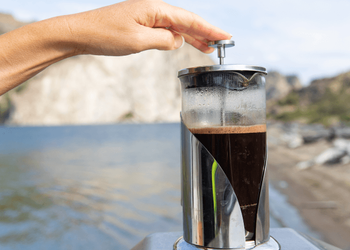
Cacao and its Journey from Beans to Bars

Ah, chocolate! It is the most heavenly sweet treat in the world that makes everything better. A spat with a friend, an unexpected expense, or a bad hair day — you name it, and chocolate fixes it all. Humans have been savoring food and drink made up of chocolate for centuries, but do you know where chocolate comes from?

You might have noticed some chocolate preparations labeled as "cacao" and "cocoa", and this is because chocolate starts as cacao beans and ends up in lip-smacking bars and concoctions
So what exactly is cacao? Learn everything about cacao beans as we uncover the bittersweet history of this ancient treat for you.
What is Cacao?
Theobroma cacao, or cacao, is the name of a tropical tree that means "food of the gods", most of which is grown in West Africa. The cacao tree produces two edible parts: the rugby ball-shaped fruit and the seeds we fondly call cacao.
Generally speaking, cacao means raw cacao beans that haven’t been roasted.
The fruit contains dozens of cacao beans used to prepare all of the world's chocolate products. So the next time you get your hands on any chocolate, know that it's the processed cacao beans you will be consuming.

The variety of cacao fruit and the region where the cacao beans come from will impact the taste of the finished product. Each region has a varying set of characteristics that will decide the personality of the cacao bean.
There are mainly three dominant varieties of cacao based on their origin: Criollo, Trinitario, and Forastero. And just like our dear coffee, chocolate prepared from cacao beans originating from just one region is known as a single origin.
Cocoa beans in detail
The bittersweet history behind Theobroma Cacao is as intriguing as the complex magic prepared from its fruit and seed.

History
Cacao trees are believed to have originated in the Upper Amazonian region in an area that today spans Peru, Ecuador, and Colombia. It then made its way to the north across the Andes and into Central American cuisine and culture, with the help of early Amerindians.
In the early 1500s, when Cortez arrived in Mexico, he discovered that cacao was deeply ingrained in the country's mythology and culture. The beans were mixed with maize and spices to make a drink that was savored by royals, warriors, and wealthy merchants. And to everyone's surprise, it was used as currency. Yes, you heard that right!
The Spaniards altered the traditional recipe by substituting maize with sugar and flavored it with cinnamon and vanilla.
Eventually, the entire continent of Europe developed a taste for this new drink, which they named chocolate, and the practice of growing cacao in tropical regions spread around the world.
Cultivation and processing
Theobroma cacao trees prefer hotter tropical conditions (65-90°F) at lower altitudes (2,000ft) and a region with plenty of rainfall but adequate soil permeability.
The cacao tree likes to be in the shadow of larger trees; therefore, it is frequently grown with mangoes and other hardwoods. This makes it an ideal plant for home gardens and smaller farms. Up to 90% of the world's cacao is now grown on farms with seven acres or less.
Cacao trees are small, reaching a maximum height of around 15 to 25 feet. A cacao tree needs about five years to reach maturity and begin yielding cacao pods (fruits). Cacao beans are housed in these pods, which grow on the main trunk and larger branches.
A single cacao tree can yield anywhere from 30 to 40 cacao pods per year. Cacao pods are harvested twice yearly, and their color ranges from green and yellow to orange and red, depending on the species.
Producers snap open seed pods holding dozens of seeds and white pulp. Farmers then separate the seeds and pulp from the pods, clean and ferment them, and send them to factories where the raw beans are transformed into finished products like powders, bars, and nibs.
Economic effects
The majority of the world's cocoa comes from millions of smallholder farmers. Even though growing cocoa requires a lot of hard work, the profit margins on cocoa beans are razor-thin. The small amount of money from cocoa production has forced farmers to rely on their children as a source of free or low-cost labor.
West African farmers produce the majority of the world's cocoa supply. Specifically, Cote D'Ivoire grows 40% of the world's cocoa supply, making it the top cocoa producer.
However, whereas the chocolate industry is over $100 billion, the cocoa sector is only worth $12 billion worldwide. There are millions of cocoa farmers in West Africa, and because of low yields, each farmer earns as little as $0.84 a day.
Prices in West African countries may be lower than in more developed countries like the United States. Regardless, the difference is not so large that people can get by on such a small amount of money every day without falling into poverty.
Cocoa trading
After the cocoa beans have been processed and dried, the farmers sell them to traders and transport them to grinders, who turn them into semi-finished goods. Once the beans have dried to perfection, they are ready to be traded. Beans are first gathered at centralized hubs where all the other farmers in the area can sell their yields.
The beans are then pooled with beans from other farms, placed in jute sacks, and are all set to be loaded onto ships for traders. The beans will likely end up in one of three major chocolate-producing countries: the United States, the Netherlands, or the United Kingdom.
Cacao tea
Cacao tea is a light and refreshing drink brewed from the outer shells of cacao beans, a treasured alternative to coffee and chocolate. Imagine savoring the tantalizing dark chocolate flavor while relishing the warmth of a hot cup of tea, altogether a blissful experience! Isn't it?
Sustainability
Cacao production around the world is quite sustainable, environmentally friendly, and socially responsible to ensure that future generations satisfy their own needs. However, there's still some work to be done in implementing practices that eliminate child labor in this sector and lead to a sustainable income for farmers.
How is cacao used?
Cacao is extremely useful and versatile. You can add cacao to smoothies, baked goods, and homemade chocolates. Not only that. The use of cacao goes beyond sweet treats and drinks.
It works wonders when added to many savory dishes and is also a great ingredient for natural skin care products. You can add it to spicy dishes and blend it with coffee to rub it on meats for that added seasoning. You can also give a treat to your taste buds by adding cacao to your coffee recipes.
What is the cacao percentage?
A growing number of chocolate bars proudly feature their cocoa percentage on their packaging. A bar of chocolate is made up of many other ingredients. The labeled percentage you see on the packaging is the weight that comes from actual cacao beans alone.
Checking the list of ingredients will give you a better idea of the percentage of cocoa used. A rule of thumb is that a high percentage of cocoa means less sugar and a darker chocolate bar. Dark chocolate lovers, you better don't settle for anything less than 80%
Cacao beans’ composition
Roughly half of each cacao bean is composed of a type of fat called cocoa butter. The beans have a high concentration of nutrients like theobromine and vitamins and contain 20% of protein. Not only are the beans rich in protein, but they also provide healthy carbohydrates and minerals.
Cacao: The elixir of gods
The Cacao bean, the seed of the Theobroma cacao tree, is the main ingredient used for centuries for preparing chocolate bars, baked goods, and beverages. After being harvested, fermented, and dried, the beans can either be consumed raw as cacao or can be roasted to bring out their cocoa aromas.
The beans can be ground into a paste to produce cocoa liquor, from which cocoa butter and cocoa powder can be extracted.

I am a coffee aficionado based in Seattle. I have devoted my passion and expertise to perfecting the art of home coffee brewing. I became known for my exquisite pour-over and espresso creations. I source coffee beans from local roasters and explores ...



